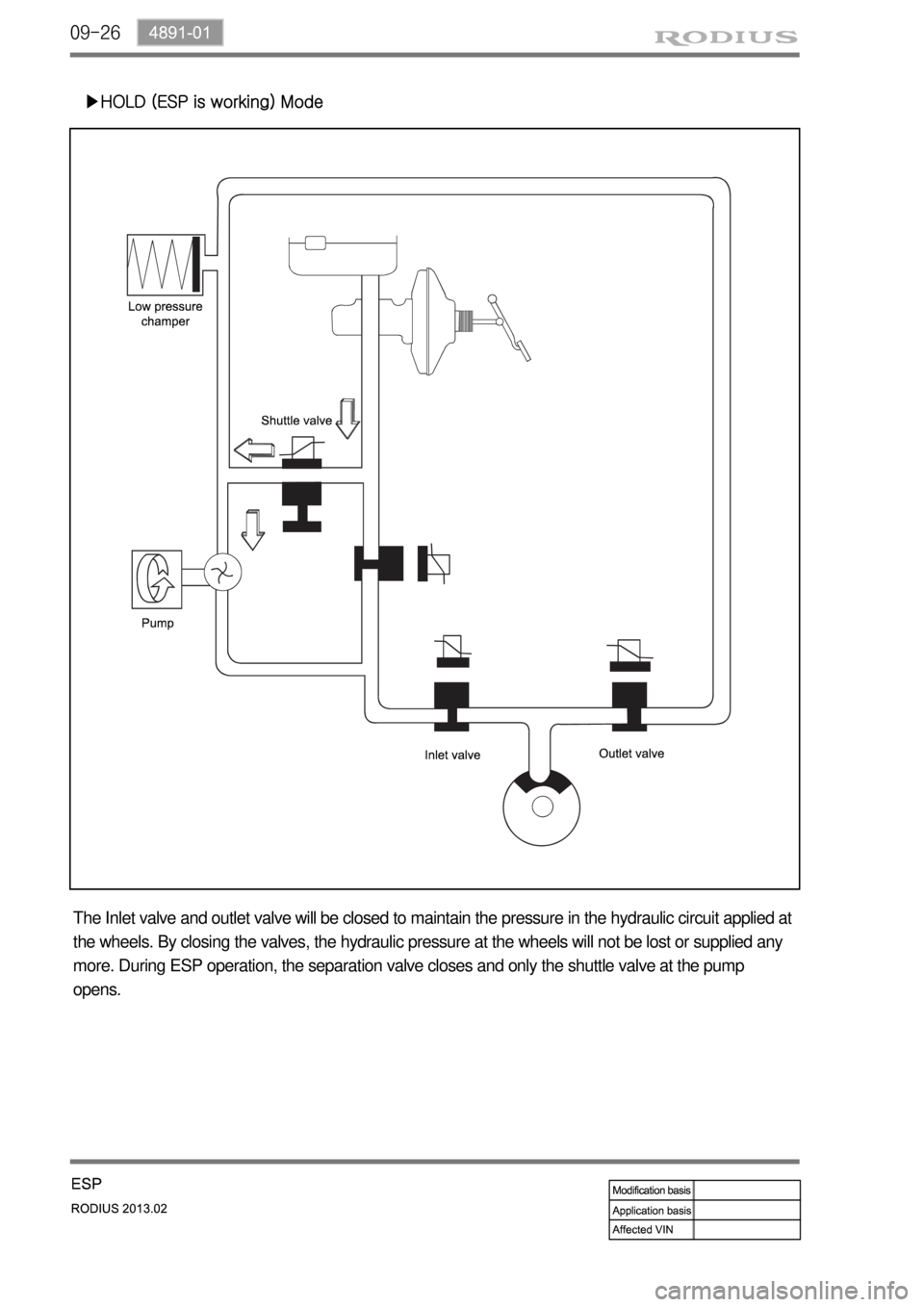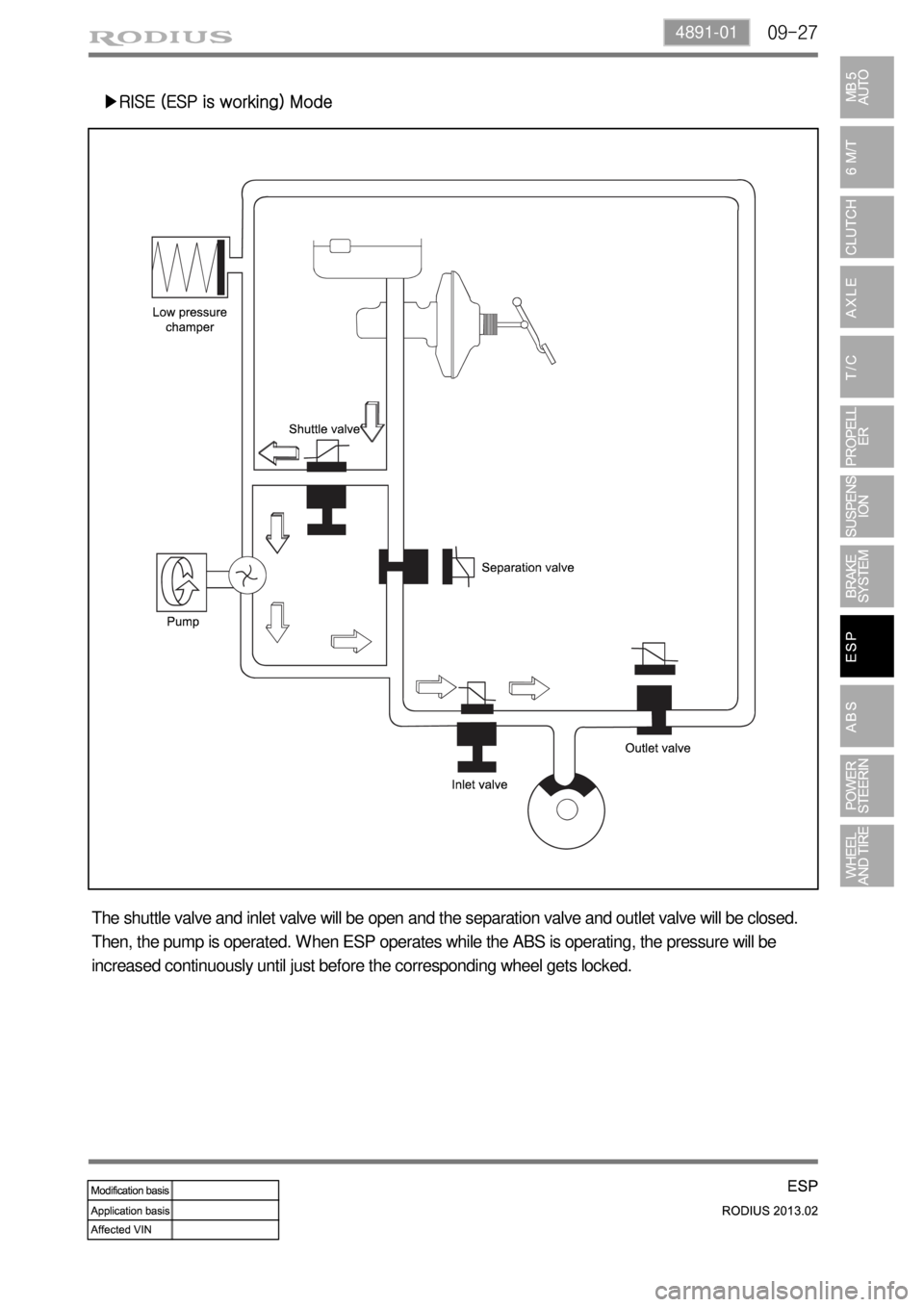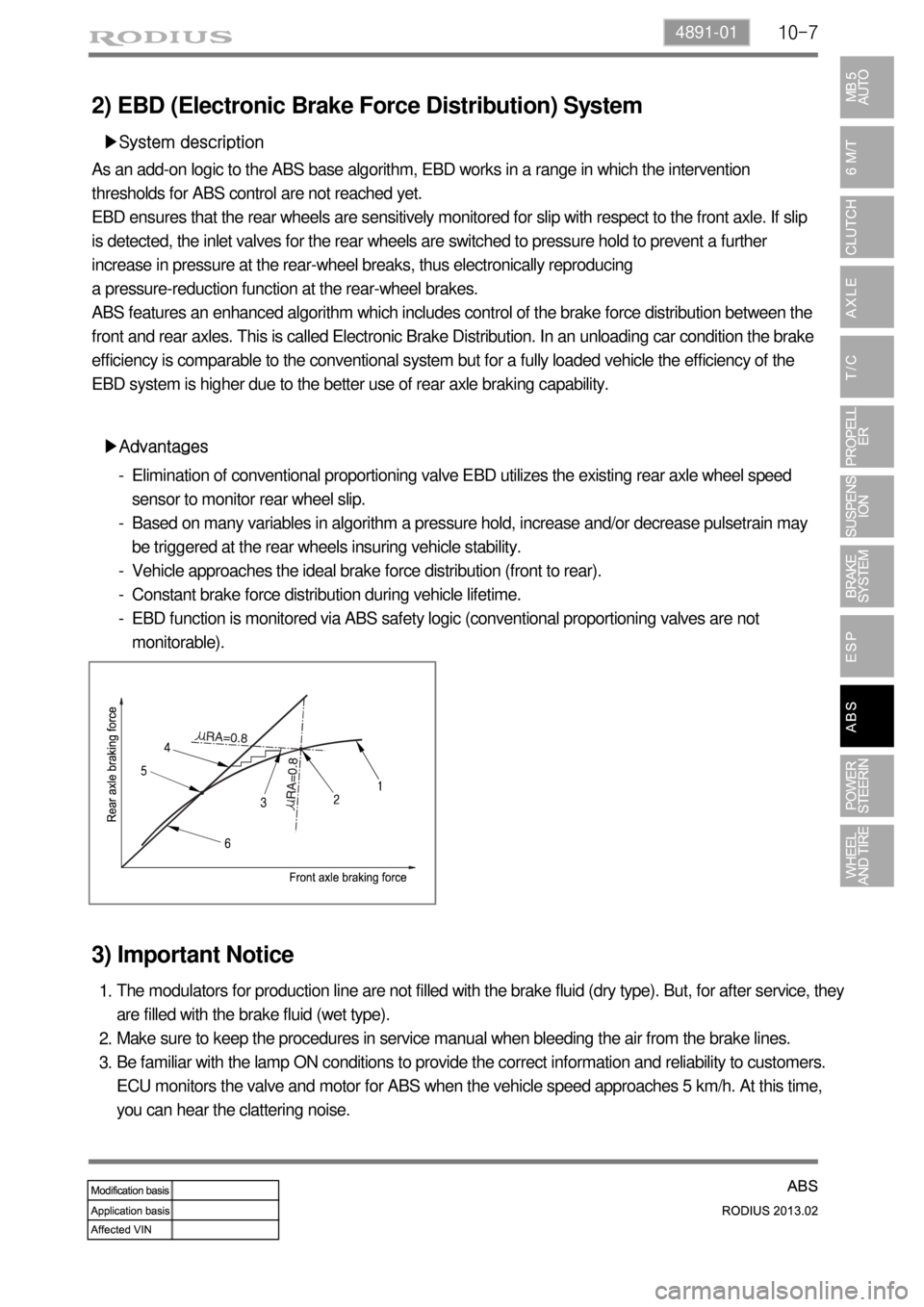ESP SSANGYONG TURISMO 2013 Workshop Manual
[x] Cancel search | Manufacturer: SSANGYONG, Model Year: 2013, Model line: TURISMO, Model: SSANGYONG TURISMO 2013Pages: 796, PDF Size: 78.99 MB
Page 672 of 796

09-26
â–¶HOLD (ESP is working) Mode
The Inlet valve and outlet valve will be closed to maintain the pressure in the hydraulic circuit applied at
the wheels. By closing the valves, the hydraulic pressure at the wheels will not be lost or supplied any
more. During ESP operation, the separation valve closes and only the shuttle valve at the pump
opens.
Page 673 of 796

09-274891-01
â–¶RISE (ESP is working) Mode
The shuttle valve and inlet valve will be open and the separation valve and outlet valve will be closed.
Then, the pump is operated. When ESP operates while the ABS is operating, the pressure will be
increased continuously until just before the corresponding wheel gets locked.
Page 674 of 796

09-28
2) Electric Circuit Diagram
Wheel speed sensor, Stop lamp switch, Self diagnostic connector, Warning lamp (ABS/ESP) â–¶
Page 675 of 796

09-294891-01
Brake Pressure Sensor, ESP Sensor, Sensor Cluster, ESP OFF Switch â–¶
Page 678 of 796

10-54891-01
Warning Lamps
EBD warning lamp ABS warning lamp
2. COMPONENTS AND LAYOUT
The basic functions of ABS system are same with previous version. However, the wheel speed
sensing type is different from previous version.
For details about the components,
refer to Chapter "ESP".
Front Active Wheel Speed Sensor
4WD 2WD
ABS HECU
Rear Active Wheel
Speed Sensor
Page 680 of 796

10-74891-01
2) EBD (Electronic Brake Force Distribution) System
â–¶System description
As an add-on logic to the ABS base algorithm, EBD works in a range in which the intervention
thresholds for ABS control are not reached yet.
EBD ensures that the rear wheels are sensitively monitored for slip with respect to the front axle. If slip
is detected, the inlet valves for the rear wheels are switched to pressure hold to prevent a further
increase in pressure at the rear-wheel breaks, thus electronically reproducing
a pressure-reduction function at the rear-wheel brakes.
ABS features an enhanced algorithm which includes control of the brake force distribution between the
front and rear axles. This is called Electronic Brake Distribution. In an unloading car condition the brake
efficiency is comparable to the conventional system but for a fully loaded vehicle the efficiency of the
EBD system is higher due to the better use of rear axle braking capability.
â–¶Advantages
Elimination of conventional proportioning valve EBD utilizes the existing rear axle wheel speed
sensor to monitor rear wheel slip.
Based on many variables in algorithm a pressure hold, increase and/or decrease pulsetrain may
be triggered at the rear wheels insuring vehicle stability.
Vehicle approaches the ideal brake force distribution (front to rear).
Constant brake force distribution during vehicle lifetime.
EBD function is monitored via ABS safety logic (conventional proportioning valves are not
monitorable). -
-
-
-
-
3) Important Notice
The modulators for production line are not filled with the brake fluid (dry type). But, for after service, they
are filled with the brake fluid (wet type).
Make sure to keep the procedures in service manual when bleeding the air from the brake lines.
Be familiar with the lamp ON conditions to provide the correct information and reliability to customers.
ECU monitors the valve and motor for ABS when the vehicle speed approaches 5 km/h. At this time,
you can hear the clattering noise. 1.
2.
3.
Page 704 of 796

12-94170-01
If weight is not equally distributed around the wheel, unbalance centrifugal force by the wheel rotation
produces vibration. As the centrifugal force is produced proportional to the square of the rotating
speed, the wheel weight should be balanced even at high speed. There are two types of the tire and
wheel balancing: static and dynamic. Abnormal vibration may also occur due to unbalanced rigidity or
size of tires.
1) Static Balance
When the free rotation of the wheel is
allowed, the heavier part is stopped on the
bottom if the wheel weight is unbalanced
and this is called "Static Unbalance". Also,
the state at which tire's stop position is not
same is called "Static Balance" when the
wheel is rotated again. If the part A is heavie
r
as shown in the figure 1, add the balance
weight of a weight corresponding to
unbalanced weight from B to A to maintain
the static balance. If the static balance is not
maintained, tramping, up and down vibration
of the wheels, occurs.
2) Dynamic Balance
The static unbalance of the wheel creates
the vibration in the vertical direction, but
the dynamic unbalance creates the
vibration in the lateral direction. As shown
in the figure 2 (a), if two parts, (2) and (3),
are heavier when the wheels are under the
static balance condition, dynamic
unbalance is created, resulting in shimmy,
left and right vibration of the wheels, and
the torque Fxa is applied in the axial
direction. To correct the dynamic
unbalance, add the balance weight of a
same weight for two points of the
circumference of the rim, A and B, as
shown in the figure 2 (b), and apply the
torque in the opposite direction to the
torque Fxa to offset in order to ensure
smooth rotation of the wheel.
Center
a
a
Fxa
Fxa F
F
A
B
(a)(b)
[Figure 1]
[Figure 2]
3. WHEEL BALANCE
Page 732 of 796

02-4
2. OPERATION
1) Air Bag
â–¶Air bag inflates when:
In response to a severe frontal impact, the driver’s and front passenger’s air bags
deploy at the same time to supplement the seat belts to prevent or reduce any personal
injuries. -
â–¶Air bag can inflate when:
Underbody impact from the road surface; impact against the curb at a very high speed;
dropping impact onto the road surface with a large angle -
â–¶Air bag does not inflate when:
Rollover, side impact or rear impact
If the severity of impact to the vehicle is not significant and the seat belts are enough to protect
occupants. -
-
Air bag seldom inflates when: â–¶
Oblique impact, rollover
Weak impact in which the sensor is unable to detect (under the inflation requirements)
Impact against narrow objects such as a utility pole or a tree
The vehicle falls into a drainage or a puddle
The front of the vehicle crashes into a high impact point vehicle such as a truck
Impact on the hood by falling stones
The air bag warning light is on
Moderate or severe impact to the middle of the vehicle body’s side structure. In that case,
only the side curtain air bags deploy. -
-
-
-
-
-
-
-
Page 776 of 796

03-377410-01
7) Warning For Child Restraint
Use only the officially approved child restraint.
Ssangyong is not responsible for the personal injury and property damage due to the defect of child
restraint.
Use only the child restraint with proper type and size for your baby.
Use only the child restraint at proper location.
Child restraint has 5 categories based on the weight as below:
GROUP 0: 0 ~ 10KG
GROUP 0+: 0 ~ 13KG
GROUP I: 9 ~ 18KG
GROUP II: 15 ~ 25KG
GROUP III: 22 ~ 36KG
Group 0 & 0+
Rear facing child restraint fitted on the rear seat
Group I
Forward facing child restraint fitted on the rear seat
Group II & III
Booster seat fitted on the rear seat with seat belt fastened
Always follow the installation and use instructions provided by the manufacturer of the booster seat. -
-
-
-
-
-
-
Page 780 of 796

04-4
2. CAUTIONS WHEN WORKING
Wear clean work clothes and gloves.
Any unauthorized modification or operational test is not allowed since the sunroof motor and control
unit are preset at the factory.
Pay attention not to drop the sunroof assembly when removing it and do not keep it right up. -
-
-
Even though the sunroof can be operated when the engine is not running, operating the sunroof
repeatedly with the engine turned off will run down the battery. Operate the sunroof while the engine
is running.
When the sunroof operation is completed, release the switch. Keeping pressing the switch can result
in malfunction.
Especially in winter, never operate the sunroof if operation areas are iced. Wait until melted.
To prevent a theft, make sure that the sunroof is completely closed when leaving the vehicle. In
addition, rain or snow can get into the vehicle through the open sunroof.
When the sunroof is fully open, wind buffeting symptom can be worse. In this case, try to adjust the
sunroof position manually or open the sunroof until the wind buffeting is disappeared
Parts of the body can be trapped in the sunroof and can be struck by passing objects. Do not stick
hands, head or anything else out of the openings.
Remove any dirt and foreign material stuck on the edge of the sunroof glass periodically. -
-
-
-
-
-
-
4. MAJOR CHANGES
Sunroof drain rear hose
Sunroof drain rear hose route changed due to rear quarter panel change
3. CAUTIONS FOR OPERATION